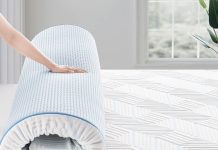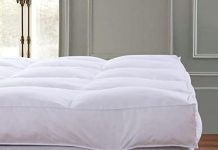When it comes to outfitting our beds with the perfect sheets, we often find ourselves asking the age-old question: How do I choose the right sheet size for my mattress? We’ve all been there, staring at a seemingly endless array of options, feeling a little lost in the sea of bed linens. But fear not, for we are here to guide you through the process and help you find the perfect fit for your mattress. So sit back, relax, and let us demystify the world of sheet sizes for you.
Review contents
Measuring Your Mattress
When it comes to choosing the right sheet size for your mattress, it’s important to start by measuring the dimensions of your mattress. This will ensure a proper fit and a comfortable night’s sleep. There are three key measurements to consider: width, length, and depth.
Measuring the Width
To measure the width of your mattress, simply take a tape measure and measure from one side of the mattress to the other. Be sure to measure at the widest point, usually from edge to edge. This will give you an accurate measurement of the width.
Measuring the Length
Measuring the length of your mattress is similar to measuring the width. Using a tape measure, measure from the head of the mattress to the foot. Again, measure at the longest point to get an accurate measurement of the length.
Considering the Depth
The depth of your mattress refers to how thick it is. This measurement is crucial when choosing the right sheet size, as it determines the pocket depth needed for a proper fit. To measure the depth, place a ruler or tape measure vertically on the side of the mattress and measure from the top to the bottom. Note this measurement as it will be useful when selecting sheets with the appropriate pocket depth.
Standard Sheet Sizes
Once you have measured your mattress, it’s time to explore the standard sheet sizes available. There are several common sizes to choose from, ranging from twin to California king. Understanding the dimensions of each size will help you make an informed decision.
Twin Size
A twin size mattress typically measures 38 inches in width and 75 inches in length. This size is ideal for single sleepers, children, or small guest rooms. Twin size sheets are widely available and come in a variety of colors and materials.
Twin XL Size
The twin XL size is a variation of the standard twin size. It has the same width of 38 inches but offers additional length, measuring 80 inches. Twin XL mattresses are commonly found in college dormitories and are suitable for taller individuals who need the extra legroom. Twin XL sheets are easy to find and ensure a proper fit for this size mattress.
Full Size
Full size mattresses, also known as double mattresses, measure 54 inches in width and 75 inches in length. This size provides more sleeping space compared to a twin but is still suitable for smaller bedrooms or guest rooms. Full size sheets are widely available and come in various styles and designs.
Queen Size
Queen size mattresses are a popular choice for couples or individuals who prefer more sleeping space. They measure 60 inches in width and 80 inches in length, providing ample room to stretch out. Queen size sheets are readily available in stores and online and offer a range of options in terms of materials and thread counts.
King Size
For those who desire even more space, a king size mattress is the way to go. King size mattresses measure 76 inches in width and 80 inches in length, offering plenty of room for couples to sleep comfortably. King size sheets are widely available and provide a luxurious and spacious fit for this size mattress.
California King Size
The California king size mattress is slightly longer and narrower compared to the standard king size. It measures 72 inches in width and 84 inches in length. This size is ideal for taller individuals who need the extra length. California king size sheets can be easily found and provide a perfect fit for this unique mattress size.
Fitted Sheet vs. Flat Sheet
When selecting sheets for your mattress, you will come across two main types: fitted sheets and flat sheets. Understanding the differences between the two will help you make an informed decision.
Fitted sheets are designed to fit snugly over the mattress and have elasticized corners that keep them in place. They are tailored to the specific dimensions and pocket depths of different mattress sizes. Fitted sheets are easy to put on and remove, and they provide a neat and secure fit. They are ideal for those who prefer a tidy and well-made bed.
On the other hand, flat sheets are rectangular and typically larger in size compared to fitted sheets. They are often used as a top sheet between the sleeper and the blanket or comforter. Flat sheets can also be tucked in or layered for added warmth. They offer versatility and can be easily swapped or washed. However, they require some effort to keep them taut and smooth.
Both fitted and flat sheets have their advantages and it ultimately comes down to personal preference. Some individuals prefer the simplicity and snug fit of a fitted sheet, while others enjoy the versatility and layering options provided by a flat sheet.
Sheet Pocket Depths
When choosing the right sheet size, it’s important to consider the pocket depth of the fitted sheet. The pocket depth refers to the height or thickness of the mattress that the fitted sheet can accommodate. Having the correct pocket depth ensures a secure fit without the sheet slipping off or coming loose during the night.
Standard Pocket Depth
Standard pocket depth refers to sheets that can fit mattresses with a depth of approximately 9 inches. This is suitable for most standard mattresses that are not overly thick or have pillow-top layers. When selecting a fitted sheet with a standard pocket depth, make sure it has enough fabric to tuck securely under the mattress.
Deep Pocket Depth
Deep pocket fitted sheets are designed to accommodate mattresses with a depth ranging from 10 to 15 inches. These sheets provide a more generous fabric allowance to fit thicker or pillow-top mattresses. If your mattress falls within this category, it’s best to opt for deep pocket sheets to ensure a proper fit.
Extra Deep Pocket Depth
For exceptionally thick or high-profile mattresses, such as those with mattress toppers or extra layers, extra deep pocket fitted sheets are the way to go. These sheets can accommodate mattresses with a depth of 16 inches or more, providing ample fabric to cover the mattress completely. It’s important to measure the depth of your mattress accurately and choose sheets with the corresponding pocket depth to avoid any fit issues.
Factors to Consider
In addition to mattress dimensions and sheet sizes, there are several other factors to consider when choosing the right sheets for your mattress. These factors can help enhance your overall comfort and sleeping experience.
Mattress Type
Different mattress types have varying thicknesses and may require specific sheet sizes. For example, memory foam mattresses are often thicker compared to traditional innerspring mattresses. It’s important to consider the depth of your mattress and choose sheets with the appropriate pocket depth to ensure a proper fit.
Personal Preference
Everyone has different preferences when it comes to the feel and texture of sheets. Some individuals prefer crisp and cool sheets, while others enjoy the softness and warmth provided by flannel sheets. Consider your personal preferences and choose materials that align with your desired sleeping experience.
Sleeping Habits
Your sleeping habits can also influence the type of sheets you choose. If you tend to move around a lot during sleep, it’s important to choose sheets that have good elasticity and can stay in place throughout the night. Additionally, if you tend to sleep hot, choosing breathable and moisture-wicking materials can help regulate your body temperature and improve your sleep quality.
Bedding Style
Finally, consider your overall bedding style and aesthetic preferences. Sheets come in a wide range of colors, patterns, and designs, allowing you to coordinate them with your existing bedding or create a fresh new look. Choosing sheets that complement your bedroom decor can enhance the overall ambiance and create a cohesive and inviting sleep environment.
Material and Thread Count
The material and thread count of your sheets can greatly impact their overall quality and feel. Sheets are available in various materials, including cotton, silk, satin, and microfiber, each with its own unique characteristics.
Cotton sheets are a popular choice due to their breathability, durability, and softness. They come in different weaves, such as percale and sateen, offering different levels of crispness and smoothness. Silk sheets provide a luxurious and smooth feel against the skin but may require more delicate care. Satin sheets are known for their silky smooth texture and shiny appearance. Microfiber sheets are often budget-friendly and offer a soft and durable option.
Thread count refers to the number of threads woven into one square inch of fabric. A higher thread count usually indicates a softer and more durable sheet. However, it’s important to note that thread count is not the only factor determining the quality of the sheets. Factors such as the type of cotton used and the weave also play a significant role in the overall feel and durability.
Consider your preferences for material, weave, and thread count when selecting sheets. It’s important to strike a balance between comfort, durability, and your budget.
Choosing the Right Sheet Size
Now that you have measured your mattress, considered the pocket depth, and explored the different factors to consider, it’s time to choose the right sheet size. Here are a few steps to help you make the best decision.
Matching Measurement to Sheet Size Chart
Start by referring to a sheet size chart, which provides the dimensions for different mattress sizes and the corresponding recommended sheet size. Match your mattress measurements to the chart and identify the appropriate sheet size.
Prioritizing Comfort and Fit
While the sheet size chart is a helpful guide, it’s important to prioritize your comfort and the fit of the sheets. If your mattress measurements fall between two standard sizes, consider the depth of your mattress and the elasticity of the fitted sheet. Opt for a slightly larger sheet if you prefer a looser fit or a slightly smaller sheet for a snug fit.
Remember that sheets should fully cover the mattress and tuck securely under the corners for a neat and tidy appearance. If in doubt, it’s always better to choose the larger size and adjust the fit using sheet clips or straps, to ensure a proper fit.
Testing the Fit
Once you have chosen and purchased your sheets, it’s important to test the fit on your mattress to ensure they are suitable.
Checking Sheet Corners
Start by checking the corners of the fitted sheet. Each corner should securely hug the mattress and not slip off or come loose. Tug gently on the corners to make sure they are anchored properly. If the corners slide off easily or feel loose, the sheet may be too big for your mattress and you may need to consider a smaller size.
Evaluating Sheet Tension
Next, evaluate the tension of the sheet. It should be taut and smooth across the surface of the mattress. Wrinkles or sagging areas indicate that the sheet may be too small or have a shallow pocket depth. Smooth out any wrinkles and ensure the sheet is evenly distributed across the mattress.
Assessing Overall Fit
Finally, step back and assess the overall fit of the sheet. It should cover the entirety of the mattress without excess fabric or gaps. Take a walk around the bed and examine the sheet from different angles to ensure a proper fit. If you notice any areas that are not covered or excessive fabric bunching up, it may be an indication that the sheet size is not suitable for your mattress.
Common Mistakes to Avoid
As you navigate the process of choosing the right sheet size, it’s important to be aware of common mistakes and avoid them.
Assuming All Sheets Are the Same Size
One of the biggest mistakes people make is assuming that all sheets are the same size. In reality, sheet sizes can vary depending on the manufacturer, country of origin, and specific product line. It’s important to measure your mattress and consult a size chart to ensure an accurate fit.
Guessing the Mattress Dimensions
Guessing the dimensions of your mattress can lead to choosing the wrong sheet size. It’s always best to measure your mattress and have the accurate measurements on hand when shopping for sheets. This will ensure a proper fit and save you from the hassle of returns or exchanges.
Not Checking the Pocket Depth
Neglecting to check the pocket depth of the fitted sheet can result in an ill-fitting sheet that does not stay in place. It’s crucial to measure the depth of your mattress and choose sheets with the corresponding pocket depth. This will ensure a secure fit and prevent the sheet from sliding off during sleep.
Conclusion
Choosing the right sheet size for your mattress is an important step towards creating a comfortable and inviting sleep environment. By measuring your mattress accurately, considering the pocket depth, and taking personal preferences into account, you can find the perfect sheets that fit impeccably and enhance your sleep experience. Remember to prioritize comfort, test the fit, and avoid common mistakes to ensure a restful and cozy night’s sleep. Happy sheet shopping!
























